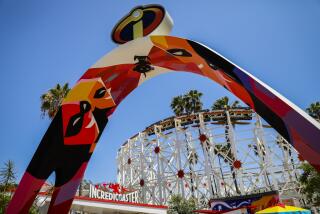As Thrills Increase, Risks to Brain Rise
- Share via
As amusement parks push the envelope with thrill rides that defy gravity and shatter freeway speed limits, the number of brain injuries like the one that a coroner’s official says may have killed a rider on a Six Flags Magic Mountain roller coaster may be increasing, experts warn.
Neurologists say the violent, jerking head movements riders endure as high-tech coasters dive and twist, a dangerous combination of speed and sudden changes in direction, can cause the sort of brain injuries cited in the death Saturday of 28-year-old Pearl Santos.
Figures on amusement park injuries are scarce because no federal agency collects them and reporting standards vary widely by state. There is also disagreement in the medical community about the risks associated with high-speed roller coasters. But a Massachusetts congressman’s research links numerous brain injuries to amusement park rides, with the reports in the 1990s rising in step with ride speeds.
“There are no public-health standards whatsoever,” said David Moulton, chief of staff for Rep. Edward Markey, a Democrat who is calling for federal oversight of amusement parks. “It’s basically an arms race to make an ever more exciting ride to spiral as high as they can get away with.”
Recent reports in medical journals have linked several brain injuries to high-speed roller coasters. In the January 2000 issue of Neurology, a researcher found a healthy 24-year-old woman who developed blood clots--subdural hematomas--on the brain, after riding several coasters at a park in Japan.
An August 2000 report in the Journal of the American Medical Assn. focused on an Italian man who developed nausea and dizziness after a roller-coaster ride. A brain scan later revealed bleeding.
Paradise for Coaster Lovers
Magic Mountain, near Valencia, has long been a destination for thrill-seekers itching for the next big plunge. It’s already the home of the world’s fastest and tallest roller coaster, the 100-mph Superman the Escape, and two more hotly anticipated coasters are set to debut this summer.
“Six Flags Magic Mountain has been on the cutting edge of coaster thrills ever since they introduced the first vertical looping coaster, the Revolution, in 1976,” said Paul Ruben, North American editor for Park World, an amusement park trade magazine. “If one loop is good, two loops is better. The appearance of the Revolution set off a roller coaster building boom that has continued unabated until this day.”
During the last two decades, by Ruben’s count, the number of roller coasters in the United States skyrocketed from 145 to almost 600. California, with 70 coasters, is the undisputed king of this hair-raising heap.
Last year, Magic Mountain unveiled Goliath, a colossal coaster that whips riders into a 235-foot free fall and through a tight corkscrew, hitting speeds of 85 mph at more than quadruple the force of gravity. On Saturday, the ride proved too much for Santos, a Fontana resident who fell unconscious on the ride and later died at a hospital of brain hemorrhaging and a ruptured cerebral artery.
On Sunday, an official of the Los Angeles County coroner’s office said Santos’ death was due to injuries she suffered on the ride. The coroner’s office said Monday that statement was premature.
In a subsequent interview, however, coroner’s Lt. Fred Corral said the medical examiner who conducted the autopsy on Santos found a preexisting “berry aneurysm,” an abnormal dilation of a vessel leading to the brain. The aneurysm apparently burst due to pressure from the wild ride, Corral said.
While officials are still performing toxicology and neuropathology tests, Corral said the rupture of Santos’ aneurysm probably triggered hemorrhaging around the brain stem.
“Based on what [the medical examiner] found, he thought it was due to the ride,” Corral said Monday, adding that a final report on the cause of death will not be issued for several weeks.
A Magic Mountain spokesman also called the findings premature. “Any medical doctor can tell you aneurysms are not caused by roller coasters,” park spokesman Andy Gallardo said. “They are a preexisting genetic condition and can rupture at any time and any place. The whole thing is very unfortunate, but it could have happened anywhere.”
The Goliath ride remained closed Monday as state inspectors sent empty trains rumbling over the tracks. They tested mechanical and electrical components, stress and speed specifications, maintenance records, and safety belts and other restraints, said Susan Gard, a spokeswoman for the state Department of Industrial Relations.
“Everything appears to have been operating as it was supposed to, from the initial reports,” Gard said. “We want to really, really take a close look at the ride itself to make sure that is true.”
The sign at the entrance to Goliath warns prospective riders: “Do not ride if you have hadrecent surgery or illness, back or neck injury, high blood pressure, heart trouble or pregnancy.”
But, like most standard theme park warnings, it makes no mention of aneurysms.
“People usually don’t know if they have an aneurysm,” Gard said. “If they have a heart condition or high blood pressure, those are things people usually know about.”
Last year, Markey asked the National Institute of Neurological Disorders and Stroke to study cases of brain injuries on roller coasters. The agency’s report, released in May 2000, cited 23 cases since 1979 that had been documented in medical journals. Nearly half of them occurred in a five-year span--from 1994 to 1999--a cluster that Moulton attributes to ever-faster coasters.
Lt. Col. James Moeller, the medical director at NASA / Dryden Flight Research Center at Edwards Air Force Base, said that in healthy people, the gravitational pull of roller coasters would not cause significant medical problems. But he said there could be dangers for those with underlying heart problems, uncontrolled high blood pressure or vascular abnormalities.
Aneurysms generally do not display symptoms and people may be unaware they have them, neurologists say. Santos’ aneurysm might have ruptured because the excitement of the ride increased her blood pressure, said Dr. Gary Duckwiler, who specializes in interventional neuroradiology at UCLA Medical Center.
The brain is cushioned by cerebral spinal fluid that acts as a shock absorber, but it can be injured as a result of whiplash in a car crash or other violent jerks of the head. Such forces can sometimes cause subdural hematomas.
Downplaying Risks to Brain
Not all researchers agree roller coasters pose high risks.
Dr. Douglas Smith, an associate professor of neurosurgery at the University of Pennsylvania Medical Center, said each roller coaster is unique and no medical study has been done conclusively linking brain injuries to the rides. Congressman Markey’s research drew from medical journals, emergency room reports and coroners’ investigations.
“What I have seen is a large number of people do fine on these rides,” Smith said.
But Kathy Fackler, a La Jolla mother whose son was injured in a roller coaster accident at Disneyland, said weak reporting standards make it difficult to gauge the size of the problem.
“These things literally fall through the cracks,” she said.
Barry Novack, a Beverly Hills attorney who represents two people who suffered apparent brain bleeds after riding Disneyland’s Indiana Jones attraction, said he has also been trying to nail down injury statistics.
“This is not an infrequent occurrence,” Novack said. “I have been saying for the last five years that these rides have the potential to cause bleeds in the brain.”
(BEGIN TEXT OF INFOBOX / INFOGRAPHIC)
Amusement Park Incidents
Since 1996, injuries at amusement parks have steadily increased, while fatalities doubled in 1999 over the previous year.
*
Injury report
Estimated amusement park ride-related injuries treated at U.S. hospital emergency rooms:
‘93: 4,830
‘94: 3,790
‘95: 4,290
‘96: 3,720
‘97: 5,460
‘98: 6,500
‘99: 7,260
*
Fatality report
Amusement park ride-related fatalities:
‘93: 1
‘94: 2
‘95: 3
‘96: 2
‘97: 1
‘98: 3
‘99: 6
*
Ride profile
Amusement park ride-related fatalities from 1987 through 1999 by ride type:
Roller coaster: 8
Water: 5
Ferris wheel: 2
Train: 2
Whirling: 2
Sleigh: 1
Unknown: 6
*
Source: U.S. Consumer Product Safety Commission
*
Times staff writers Annette Kondo, Andrew Blankstein and Martha L. Willman contributed to this story.
More to Read
Inside the business of entertainment
The Wide Shot brings you news, analysis and insights on everything from streaming wars to production — and what it all means for the future.
You may occasionally receive promotional content from the Los Angeles Times.











